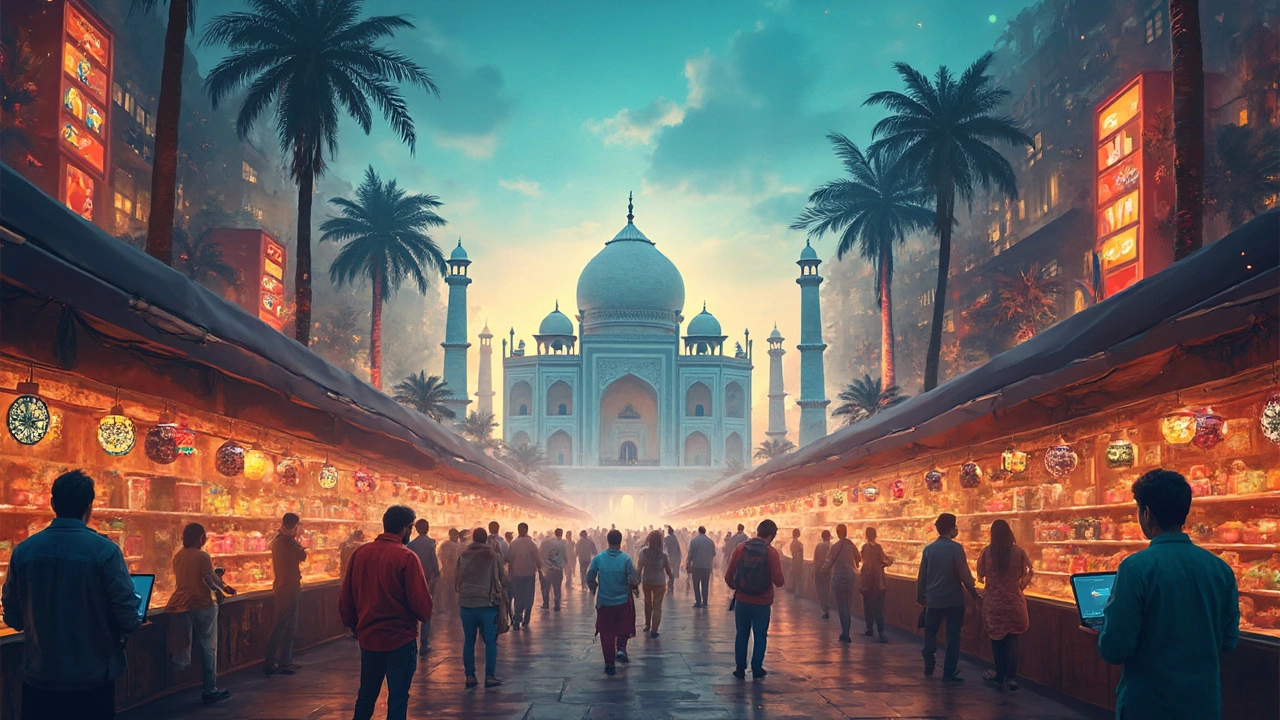Picture India’s bustling bazaars, now transformed into bits and bytes; that’s the nation’s e-commerce scene today. Amazon is a juggernaut worldwide, but in India, the competition is fierce. The rival in the spotlight? Flipkart, the homegrown startup that's making waves across the subcontinent.
You might wonder, how did Flipkart grow to challenge Amazon on its own turf? It's all about understanding the local pulse. Founded by former Amazon employees, Flipkart knows what tickles the fancy of Indian shoppers. With strategic sales events like the Big Billion Days, they’ve captured significant attention.
Sure, Flipkart's big, but it's not alone. India has a slew of other platforms eager to grab a slice of the online pie. Companies like Snapdeal and Reliance's JioMart are hustling to stay relevant by offering competitive pricing and local products.
- The Indian E-commerce Landscape
- Flipkart: A Force to Reckon With
- Local Flavor: Homegrown Contenders
- The X Factor: Market Trends and Consumer Preferences
- What's Next for E-commerce in India?
The Indian E-commerce Landscape
India's e-commerce scene isn't just alive; it's thriving and bustling with energy. As one of the fastest-growing markets globally, it's no wonder international giants like Amazon have set up shop. But, they’re not navigating in calm waters. The landscape is dynamic, with local players like Flipkart making significant headway.
With an internet user base of over 600 million, India is a digital playground. Combine this with a smartphone revolution and economic growth, and you've got all the ingredients for a booming e-commerce industry. The rise of affordable data plans has further spurred online shopping, reaching even the rural and remote areas.
Unique Indian Consumer Behavior
Buying habits here blend modernity and tradition. Preferences lean towards cash on delivery options, even as digital payments are picking up steam. Shoppers look for festive offers, as cultural holidays have their own shopping sprees. E-commerce platforms keep a keen eye on this, aligning their sales events with festivals and seasons.
Local Players and Strategies
Flipkart isn’t just playing Amazon's game; it’s redefining it by focusing on India's heartland. Offering regional language support, Flipkart connects with diverse consumer bases, a strategy resonating well across the country.
- Amazon India competitor: Besides Flipkart, platforms like Myntra (focused on fashion) and Nykaa (beauty products) chip away at specific niches.
- Online grocery platform: JioMart is steadily gaining ground in the grocery segment, tapping into Reliance's massive offline retail network.
- Enhancing technology: Sellers leverage artificial intelligence for personalized recommendations while combating logistics challenges with last-mile delivery innovations.
As of recent years, the push for digital transformation accelerated by COVID-19 has further embedded these trends. Companies that swiftly embraced newer technologies thrive amid consumer expectations soaring beyond just products to experiences. The race to capture the highly desirable online shopper continues to intensify.
Flipkart: A Force to Reckon With
When talking about the titan challenging Amazon in India, Flipkart inevitably comes into the conversation. Since its inception in 2007, Flipkart has grown from a small online bookstore to a massive e-commerce platform, reaching millions of Indian households.
The Rise of Flipkart
Flipkart's journey started from a humble two-bedroom flat in Bangalore, and its founders, Sachin Bansal and Binny Bansal (no relation), both former Amazon employees, had a clear vision: cater to the unique needs of the Indian consumer. Flipkart's dynamic approach included everything from offering cash-on-delivery to creating Big Billion Days, a massive sales event to rival Amazon's Prime Day.
A Winning Strategy
So, what makes Flipkart a real contender? For one, it's their understanding of local tastes. Flipkart introduced innovations like easy returns and efficient logistics strategies tailored for India's diverse landscape. It doesn’t hurt that Flipkart knows what sells, making strategic alliances, like its 2018 acquisition by Walmart, to further cement its position.
Flipkart's Catalog and Services
- Electronics and gadgets, ranging from basics to the latest smartphones.
- Fashion, featuring local and international brands reflecting India's varied fashion tastes.
- Homeware and appliances, offering everything from cookware to furniture.
With a robust presence in electronics, fashion, and appliances, Flipkart also stirs up demand through exclusive launches and deals.
Competitive Edge
The real game-changer? Flipkart’s digital wallet system (one of the first in India) and its loyalty programs, designed to reward repeat customers and keep them coming back. By offering unique payment options and robust logistics, Flipkart ensures it's a tough rival for any global giant.
Market Insights
Statistics show Flipkart holds a significant market share in Indian e-commerce, second only to Amazon India, with burgeoning sales figures especially during festive seasons. A testament to its innovation and understanding of local culture.
With these strategies up its sleeve, Flipkart stands as a formidable opponent in a country where online shopping is steadily becoming as popular as a trip to the market.

Local Flavor: Homegrown Contenders
The Indian e-commerce scene isn't just a battle between Amazon India competitor Flipkart and the global giant. Several indigenous platforms are making a mark by catering to the unique needs and preferences of local consumers.
Snapdeal: The Budget-Friendly Alternative
Take Snapdeal, for instance. It emerged as an early player in India's online shopping world, focusing on affordability and a diverse range of products. Snapdeal targets shoppers who are cost-conscious and always on the lookout for bargains. It's not just about competing with the big guys; they're carving a niche with everyday essentials at budget prices.
Reliance JioMart: Integrated Shopping Experience
Then there's Reliance, a household name in India, which entered the digital marketplace with JioMart. This platform leverages Reliance's extensive retail presence and telecom network to provide an integrated online-offline shopping experience. By offering everything from groceries to electronics, JioMart appeals to urbanites and suburbanites who value convenience.
Myntra: Fashion at the Forefront
For fashionistas, Myntra stands tall as a go-to destination. It’s part of the Flipkart family now, but it brings its own flair to the game. Focused mainly on clothing, accessories, and cosmetics, Myntra taps into India's youthful and style-conscious demographic, often collaborating with Bollywood celebrities to boost its appeal.
Indian ecommerce platforms: An Array to Choose From
Besides these big names, platforms like Paytm Mall and Tata Cliq are also trying to make an impact. Each offers something distinctive, whether it's exclusive deals on electronics or luxury items.
With a plethora of choices, consumers benefit dramatically. This competition ensures that prices remain fair, quality improves, and the range of offerings continues to expand. The online shopping India landscape is vibrant, weaving together tradition and tech in ways that redefine retail.
The X Factor: Market Trends and Consumer Preferences
India's ecommerce platforms are thriving in an ever-changing market landscape fueled by evolving consumer preferences. So, what's really driving these trends? Let's break it down.
Youthful Demographics
With over half of India's population under the age of 25, the young crowd is shaping the future of online shopping. They're tech-savvy, always on their phones, and love a good bargain in their native language. Platforms are catering to this demographic by rolling out user-friendly apps and vernacular languages.
Payment Preferences
India's love for cash is legendary, but the rise of digital is hard to ignore. Amazon India and Flipkart have tapped into this trend, offering multiple payment options like UPI, digital wallets, and cash on delivery. This has made shopping online accessible to everyone, not just the techies.
Local Products and Personalization
Consumers crave products that resonate with their cultural tastes and preferences. Platforms are increasingly offering regional goods and personalized shopping experiences, from cuisine to clothing. It pays off, as shoppers feel more connected and, frankly, seen.
The Rise of Quick Commerce
In the era of instant gratification, India’s urbanites want their products faster than ever. The quick commerce trend is soaring, with 10–30-minute delivery options popping up in big cities. Flipkart is keeping up with initiatives like Flipkart Quick, satisfying that need-for-speed.
| Trend | Effect on Market |
|---|---|
| Discount Shopping Festivals | Significantly boost sales volumes |
| Mobile Internet Usage | Increased app engagement and transactions |
| Cashbacks and Offers | Higher customer retention |
These market trends aren't just ephemeral blips; they're reshaping how online shopping in India functions, catering to the needs and desires of a diverse audience. For sellers, understanding these trends isn't just advantageous; it's essential for survival.

What's Next for E-commerce in India?
E-commerce in India is an evolving beast. As the internet penetrates even the remotest corners, online shopping is poised to become a daily habit for more people. Big players like Amazon and Flipkart aren't resting on their laurels; they're gearing up for an even fiercer competition.
Young Population, Big Opportunities
With a young demographic that’s rapidly embracing digital, the potential is massive. Half of the Indian population is under 25, and these digital natives are looking for convenience and variety. E-commerce platforms that tap into this will see substantial growth.
Tech Trends and Innovations
Technology is shaping the future. AI, augmented reality shopping experiences, and seamless payment options are becoming game-changers. As quoted by Rishi Vasudev, an industry expert,
"The next wave will be determined by who adapts technology best. Personalized shopping is what the future holds."
Impact of Localisation
Tailoring services to regional needs is crucial. For instance, implementing local languages on websites and voice-based shopping are increasingly important. This localization allows platforms to connect with a diverse customer base more deeply.
Here’s a quick snapshot of the expected growth:
| Year | E-commerce Market Size (in billions USD) |
|---|---|
| 2025 | 200 |
| 2027 | 350 |
Government Policies and Regulations
Another factor is how the Indian government navigates e-commerce laws. There's an ongoing push for stricter regulations to protect small retailers. This could shape how these e-commerce platforms operate moving forward.
The road ahead is filled with opportunities and challenges. Companies willing to innovate and localize will likely lead the charge in India's vibrant e-commerce landscape.

